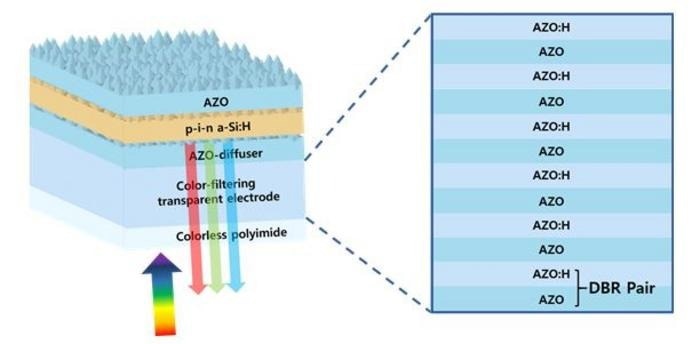The world’s first transparent thin-film solar cell has been created by a research team under the direction of Dr. Jung-dae Kwon from the Department of Energy & Electronic Materials at the Korea Institute of Materials Science (KIMS), on a flexible substrate that displays various reflective colors without significantly reducing solar cell efficiency. The Ministry of Science and ICT oversees the government-funded research facility known as KIMS.
 A transparent thin-film solar cell on a flexible substrate made by periodically mixing hydrogen with aluminum-doped zinc oxide material to realize color. Image Credit: Korea Institute of Materials Science (KIMS)
A transparent thin-film solar cell on a flexible substrate made by periodically mixing hydrogen with aluminum-doped zinc oxide material to realize color. Image Credit: Korea Institute of Materials Science (KIMS)
By regularly adding hydrogen to zinc oxide material doped with aluminum, a transparent electrode, to cause a refractive index difference, reflected color exclusively in a single material is produced.
The reflection loss in the visible light area absorbed by the solar cell device was reduced by creating a multi-layer thin film with an incredibly low refractive index difference of less than 5%. Since the incorporation of color hardly lowers the solar cell efficiency, it can be used with a variety of absorbers for thin-film solar cells.
It is also anticipated to act as a standard for enhancing the aesthetics of flexible substrate transparent thin-film solar cells for BIPV (Building Integrated Photo Voltaic) and VIPV (Vehicle Integrated Photo Voltaic) applications.
To date, multilayer thinning technology for materials with large refractive index differences, color control thin film coating technology for designing optical properties, and natural structure mimicking structural color technology have been used as color application methods to improve the aesthetics of transparent thin film solar cells.
These methods, however, are not suited for solar cells that absorb visible light due to a wide reflection band and high reflectivity, or they need sophisticated technologies that are difficult to implement industrially in terms of two or more materials and processes.
The study team exploited periodic hydrogen reactions to generate multilayer thin films with varying refractive indices while forming zinc oxide thin films using the vacuum sputtering deposition method used in standard semiconductor and solar cell manufacturing procedures.
They then acquired the three primary colors of light by varying the thickness of the multilayer thin film. The color of the electrode was successfully implemented at the time, even when applied to a solar cell that absorbs light in the visible light spectrum.
A multilayer transparent thin film electrode made of a single material requires no extra processing. Thin film solar cells with varied colors and excellent efficiency are expected to be produced at a reasonable cost. Furthermore, because the reflecting color is implemented as an optical filter, it can be used in a variety of fields, including image sensors, photolithography masks, and infrared shielding.
When commercialized, this technology will help to develop simple and process-free light filter technology and high-efficiency colored flexible substrate transparent thin-film solar cells, as well as to realize BIPV systems for modern buildings and VIPV systems for vehicles with aesthetic features.
Dr. Jung-dae Kwon, Study Principal Researcher and Senior Researcher, Department of Energy & Electronic Materials, Korea Institute of Materials Science
The study was conducted as part of the Korea Institute of Materials Science’s fundamental research project and energy technology development project of the Korea Institute of Energy Technology Evaluation and Planning with assistance from the Ministry of Science and ICT.
The study’s findings were also published on August 3rd, 2023 in the Chemical Engineering Journal (IF: 15.1), a prestigious journal (ranked in the top 3%) in the field of chemical engineering (First Author: Dr. Choi Soo-won, Corresponding Authors: Professor Punggeun Song of Pusan National University and Professor Myung Hoon Shin of Korea Aerospace University).
The research team is actively undertaking follow-up research in the area of solar modules that express color while taking into account both the esthetic and functional elements of BIPV based on the findings of this study.
Journal Reference:
Choi,S.-W., et al. (2023) Flexible multi-layered coloring transparent electrode composed of AZO–based materials. Chemical Engineering Journal. doi:10.1016/j.cej.2023.145226